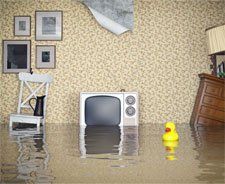JC Wood Blog
>
10 Steps to Take When Water Invades Your Home
10 Steps to Take When Water Invades Your Home
Tuesday, August 30, 2016 3:17 PM

Unexpected flooding can be a costly and time consuming affair. Between damage to property and the threat of harmful mold, the experience can be overwhelming for any homeowner. After the water recedes, follow these steps to mitigate damage and put your house back in order.
During flooding
1. When you first notice flooding in your home, shut off the water main as soon as possible. If you are unable to locate the water main, contact a plumber or professional immediately.
2. Turn off the electricity in the flooded rooms at the main breaker. If you see any sparks or smell gas, leave your home and immediately call the fire department.
3. Move any furniture that is affected by the water to higher or dryer ground. Spot dry fabric and wood as much as possible and place a fan near the furniture to speed up the process.
After the Flood
4. Contact your insurance company and take photographs of the damage as soon as it is safe to enter your home. The insurance company may advise you to wait for an adjuster before removing any flooring or carpeting, or may advise you to begin with the cleanup.
5. Get rid of as much water as possible with a vacuum or pump designed to hold liquids. Open your windows and turn on any fans and the A/C unit in your home to speed up the drying process.
6. Call a local disaster recovery or junk removal company to pick up any carpeting or flooring that has been damaged beyond repair. Dispose of any items that cannot be refurbished, and set aside any furniture or items that can be restored.
7. Call a mold inspector to take samples of your home and diagnose any potential issues. Mold removal can require destruction of entire walls or floors, so it is important to determine if there is an issue before you start rebuilding.
8. Once you have heard back from the mold inspector and your insurance adjuster, begin repairing any structural damage, which may include new flooring, drywall, or electrical work.
9. Contact a professional restoration company to refurbish any items that were not destroyed in the flooding. Professionals can easily restore items, such as chairs, tables, and cabinets to their original beauty. This will save you the cost and headache of having to purchase new furnishings.
10. After the cleanup and rebuilding is complete, review your insurance coverage to make sure your policy is sufficient. It is much easier to gauge whether your insurance will be adequate for future incidents after you have experienced one.
Do you have water damaged furniture or cabinets? Call J.C. Wood today!





